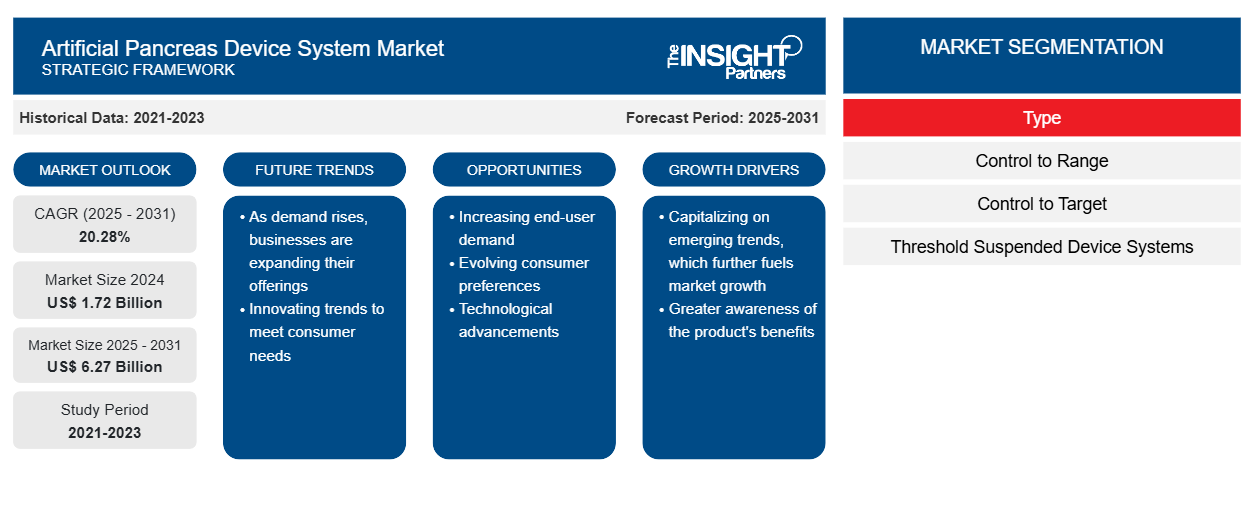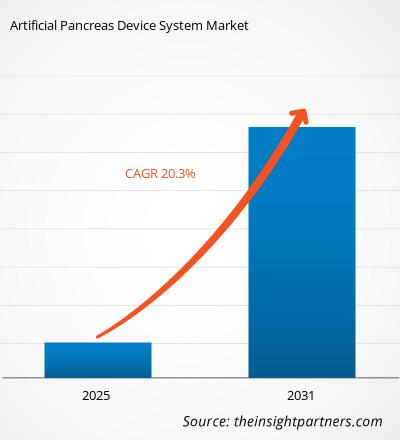من المتوقع أن يصل سوق نظام جهاز البنكرياس الاصطناعي إلى 3,585.75 مليون دولار أمريكي بحلول عام 2031 من 1,190.23 مليون دولار أمريكي في عام 2022؛ ومن المتوقع أن ينمو بمعدل نمو سنوي مركب قدره 20.28٪ من 2022 إلى 2031.
تُحاكي أنظمة أجهزة البنكرياس الاصطناعي وظيفة تنظيم الجلوكوز في البنكرياس السليم. لا يقتصر عمل الجهاز على مراقبة مستويات الجلوكوز في الجسم فحسب، بل يُضبط توزيع الأنسولين تلقائيًا لخفض مستويات الجلوكوز في الدم، ويُقلل من حالات انخفاضه دون أي تدخل من المرضى. ووفقًا لإدارة الغذاء والدواء الأمريكية، يرتبط استخدام البنكرياس الاصطناعي بتحكم أفضل في مستويات السكر في الدم لدى مرضى السكري من النوع الأول مقارنةً بالعلاج التقليدي.
يُقسّم سوق أجهزة البنكرياس الاصطناعي حسب النوع والتوزيع الجغرافي. ويُقسّم السوق جغرافيًا إلى أمريكا الشمالية، وأوروبا، وآسيا والمحيط الهادئ، والشرق الأوسط وأفريقيا، وأمريكا الجنوبية والوسطى. يُقدّم التقرير رؤىً وتحليلاتٍ مُعمّقة للسوق، مُركّزًا على معايير مثل اتجاهات السوق، والتطورات التكنولوجية، وديناميكيات السوق، بالإضافة إلى تحليلٍ للمنافسة بين أبرز الشركات العالمية في هذا السوق.
ستحصل على تخصيص لأي تقرير - مجانًا - بما في ذلك أجزاء من هذا التقرير، أو تحليل على مستوى الدولة، وحزمة بيانات Excel، بالإضافة إلى الاستفادة من العروض والخصومات الرائعة للشركات الناشئة والجامعات
سوق أجهزة البنكرياس الاصطناعي: رؤى استراتيجية

- احصل على أهم اتجاهات السوق الرئيسية لهذا التقرير.ستتضمن هذه العينة المجانية تحليل البيانات، بدءًا من اتجاهات السوق وحتى التقديرات والتوقعات.
رؤى السوق
انتشار مرض السكري المتزايد يعزز سوق أجهزة البنكرياس الاصطناعي
داء السكري مرض مزمن يُهدد الحياة، ولا يوجد له علاج مُتخصص. وينتج هذا المرض بشكل رئيسي عن عدم قدرة الجسم على إنتاج هرمون الأنسولين أو استخدامه بفعالية. ويُعتبر من أكبر الأزمات الصحية العالمية في القرن الحادي والعشرين. يمنع داء السكري الجسم من تنظيم مستويات الجلوكوز في الدم بشكل كافٍ. هناك نوعان من داء السكري: داء السكري من النوع الأول (المعروف أيضًا باسم السكري الكاذب) وداء السكري من النوع الثاني (المعروف أيضًا باسم داء السكري السكري). وتُعدّ السمنة، ونمط الحياة الخامل، والعادات الغذائية غير الصحية عوامل الخطر الرئيسية المرتبطة بالتزايد السريع في أعداد المصابين بداء السكري.
وفقًا للاتحاد الدولي للسكري (IDF)، من المتوقع أن يرتفع عدد المصابين بالسكري في أمريكا الشمالية من حوالي 46 مليونًا في عام 2017 إلى حوالي 62 مليونًا بحلول عام 2045؛ ومن المرجح أن يرتفع معدل انتشار المرض بنسبة حوالي 35٪ خلال فترة التنبؤ. ووفقًا للجمعية الأمريكية للسكري، فإن حوالي 30.3 مليون شخص، أي ما يصل إلى 9.4٪ من سكان الولايات المتحدة، يعانون من مرض السكري؛ ومن بين هذا العدد، عانى 1.25 مليون طفل من مرض السكري من النوع الأول في عام 2017. كما تنص المعاهد الوطنية للصحة أيضًا على أن معدل الإصابة بمرض السكري من النوع الأول يتزايد بسرعة في جميع أنحاء العالم، مما يؤثر على عدد كبير من الأطفال والمراهقين. ووفقًا للمصدر نفسه، يعاني حوالي 84 مليون شخص في جنوب شرق آسيا من مرض السكري في عام 2017. ومن بين هؤلاء المرضى، يعاني 149300 طفل من مرض السكري من النوع الأول ويحتاجون إلى جرعة يومية من حقن الأنسولين. يعد مرض السكري من النوع الثاني هو الشكل الأكثر انتشارًا لمرض السكري، وقد زاد جنبًا إلى جنب مع التغيرات الثقافية والمجتمعية. في الدول ذات الدخل المرتفع، يُصاب ما يصل إلى 91% من البالغين المصابين بالسكري من النوع الثاني. ووفقًا للاتحاد الدولي للسكري، كان حوالي 425 مليون شخص حول العالم مصابين بالسكري في عام 2017، ومن المتوقع أن يصل هذا العدد إلى 629 مليونًا بحلول عام 2045.
يمكن أن يؤدي داء السكري بجميع أنواعه إلى مضاعفات مختلفة في أجزاء عديدة من الجسم، وقد يزيد من خطر الوفاة المبكرة. ومن أهم المضاعفات المرتبطة بهذا المرض: النوبات القلبية، والسكتات الدماغية، والفشل الكلوي، وبتر الساق، وفقدان البصر، وتلف الأعصاب. ويحتاج مرضى السكري إلى مراقبة دورية وإعطاء الأنسولين خارجيًا.
رؤى النوع
بناءً على النوع، يُقسّم سوق أنظمة أجهزة البنكرياس الاصطناعي إلى أنظمة التحكم في النطاق والتحكم في الهدف وأنظمة الأجهزة المعلقة عند العتبة. في عام 2022، استحوذ قطاع أنظمة الأجهزة المعلقة عند العتبة على أكبر حصة من السوق. ومن المتوقع أيضًا أن يسجل القطاع أعلى معدل نمو سنوي مركب خلال الفترة 2022-2031. مع أنظمة أجهزة تعليق العتبة، والمعروفة أيضًا بأنظمة تعليق الجلوكوز المنخفض، يتم تعليق توصيل الأنسولين لفترة زمنية محددة عندما يكون مستويان من الجلوكوز أقل من مستوى منخفض محدد، مما يشير إلى نقص سكر الدم. يساعد الجهاز المعلق عند العتبة على عكس انخفاض مستويات الجلوكوز في الدم. مع أنظمة أجهزة تعليق العتبة، والمعروفة أيضًا بأنظمة تعليق الجلوكوز المنخفض، يتم تعليق توصيل الأنسولين لفترة زمنية محددة عندما يكون مستويان من الجلوكوز أقل من مستوى منخفض محدد. لا يمكن للأجهزة المعلقة عند العتبة الاستجابة لحالة انخفاض سكر الدم (نقص سكر الدم).
تُعدّ عمليات إطلاق المنتجات وعمليات الدمج والاستحواذ من الاستراتيجيات الأكثر شيوعًا بين الشركات العاملة في سوق أنظمة أجهزة البنكرياس الاصطناعي العالمية. وفيما يلي بعض أهم تطورات المنتجات الحديثة:
- في يونيو 2021، حصلت شركة Medtronic على علامة CE لنظام MiniMed 780G لعلاج مرضى السكري من النوع الأول من الفئة العمرية من 7 إلى 80 عامًا.
- في أبريل 2022، تعاونت شركة Abbott مع Ypsomed وCamDiab لإحضار نظام البنكرياس الاصطناعي إلى أوروبا.
- في يناير 2021، أطلقت شركة ميدترونيك نظام MiniMed 780G في المملكة المتحدة. وهو نظام متطور هجين لتوصيل الأنسولين بحلقة مغلقة، يُستخدم لإدارة مرض السكري من النوع الأول للأشخاص الذين تتراوح أعمارهم بين 7 و80 عامًا.
سوق أجهزة البنكرياس الاصطناعي - تجزئة السوق
من حيث النوع، يُقسّم سوق أنظمة أجهزة البنكرياس الاصطناعي إلى أنظمة تحكم بالمدى، وأنظمة تحكم بالهدف، وأنظمة تعليق العتبة. وينقسم السوق جغرافيًا إلى: أمريكا الشمالية (الولايات المتحدة الأمريكية، كندا، المكسيك)، وأوروبا (فرنسا، ألمانيا، المملكة المتحدة، إيطاليا، إسبانيا، وبقية دول أوروبا)، وآسيا والمحيط الهادئ (الصين، اليابان، الهند، أستراليا، كوريا الجنوبية، وبقية دول آسيا والمحيط الهادئ)، والشرق الأوسط وأفريقيا (المملكة العربية السعودية، جنوب أفريقيا، الإمارات العربية المتحدة، وبقية دول الشرق الأوسط وأفريقيا)، وأمريكا الجنوبية والوسطى (البرازيل، الأرجنتين، وبقية دول أمريكا الجنوبية والوسطى).
ملفات تعريف الشركة
- مُتحدّى
- شركة تايب زيرو للتكنولوجيا
- شركة إنسوليت
- شركة بيج فوت للطب الحيوي
- ميدترونيك
- شركة ديكسكوم
- أدميتسيس
- بيتا بايونيكس
- سيلنوفو
- تانديم لرعاية مرضى السكري
نطاق التقرير
رؤى إقليمية حول سوق نظام جهاز البنكرياس الاصطناعي
قام محللو شركة The Insight Partners بشرح شامل للاتجاهات والعوامل الإقليمية المؤثرة في سوق أنظمة البنكرياس الاصطناعي خلال فترة التوقعات. كما يناقش هذا القسم قطاعات سوق أنظمة البنكرياس الاصطناعي ونطاقها الجغرافي في أمريكا الشمالية، وأوروبا، وآسيا والمحيط الهادئ، والشرق الأوسط وأفريقيا، وأمريكا الجنوبية والوسطى.
نطاق تقرير سوق نظام جهاز البنكرياس الاصطناعي
| سمة التقرير | تفاصيل |
|---|---|
| حجم السوق في عام 2024 | 1.72 مليار دولار أمريكي |
| حجم السوق بحلول عام 2031 | 6.27 مليار دولار أمريكي |
| معدل النمو السنوي المركب العالمي (2025 - 2031) | 20.28% |
| البيانات التاريخية | 2021-2023 |
| فترة التنبؤ | 2025-2031 |
| القطاعات المغطاة | حسب النوع
|
| المناطق والبلدان المغطاة | أمريكا الشمالية
|
| قادة السوق وملفات تعريف الشركات الرئيسية |
|
كثافة اللاعبين في سوق نظام جهاز البنكرياس الاصطناعي: فهم تأثيره على ديناميكيات الأعمال
يشهد سوق أنظمة أجهزة البنكرياس الاصطناعي نموًا سريعًا، مدفوعًا بتزايد طلب المستخدمين النهائيين نتيجةً لعوامل مثل تطور تفضيلات المستهلكين، والتقدم التكنولوجي، وزيادة الوعي بفوائد المنتج. ومع تزايد الطلب، تعمل الشركات على توسيع عروضها، والابتكار لتلبية احتياجات المستهلكين، والاستفادة من الاتجاهات الناشئة، مما يعزز نمو السوق.

- احصل على نظرة عامة على أهم اللاعبين الرئيسيين في سوق نظام جهاز البنكرياس الاصطناعي
- التحليل التاريخي (سنتان)، سنة الأساس، التوقعات (7 سنوات) مع معدل النمو السنوي المركب
- تحليل PEST و SWOT
- حجم السوق والقيمة / الحجم - عالمي، إقليمي، بلد
- الصناعة والمنافسة
- مجموعة بيانات إكسل
التقارير الحديثة
شهادات العملاء
سبب الشراء
- اتخاذ قرارات مدروسة
- فهم ديناميكيات السوق
- تحليل المنافسة
- رؤى العملاء
- توقعات السوق
- تخفيف المخاطر
- التخطيط الاستراتيجي
- مبررات الاستثمار
- تحديد الأسواق الناشئة
- تحسين استراتيجيات التسويق
- تعزيز الكفاءة التشغيلية
- مواكبة التوجهات التنظيمية






















 احصل على عينة مجانية ل - سوق أنظمة أجهزة البنكرياس الاصطناعي
احصل على عينة مجانية ل - سوق أنظمة أجهزة البنكرياس الاصطناعي